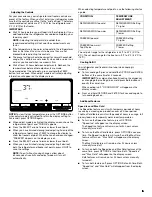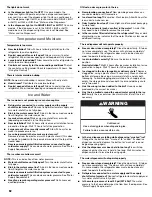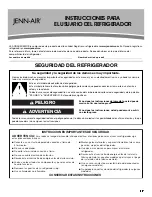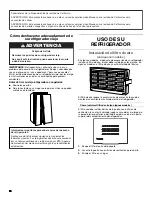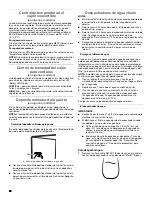
10
10
10
10
10
10
3. Wash stainless steel and painted metal exteriors with a clean
sponge or soft cloth and a mild detergent in warm water.
4. On some models, wash glass door panels with a clean
sponge or soft cloth and a mild detergent in warm water.
NOTE: Do not hit the glass with pots, pans, furniture, toys, or
other objects. Scratching, hitting, jarring or stressing the
glass may weaken its structure, causing an increased
likelihood of breakage at a later date.
5. There is no need for routine condenser cleaning in normal
home operating environments. If the environment is
particularly greasy or dusty, or there is significant pet traffic in
the home, the condenser should be cleaned every 2 to
3 months to ensure maximum efficiency.
If you need to clean the condenser:
■
Remove the base grille. See the “Door Removal”
instructions, either in the User Instructions or the
Installation Instructions and Owner’s Manual, or in the
separate instruction sheet provided with your refrigerator.
■
Use a vacuum cleaner with a soft brush to clean the grille,
the open areas behind the grille and the front surface area
of the condenser.
■
Replace the base grille when finished.
6. Plug in refrigerator or reconnect power.
Lights
IMPORTANT: The refrigerator and freezer compartments, air
tower and dispenser lights are LEDs that cannot be changed by
yourself. To order replacement LED lightings, please,
call Whirlpool service (1-800-253-1301 (U.S.A.) or
1-800-807-6777 (Canada).
Vacation and Moving Care
Vacations
If You Choose to Leave Refrigerator On While You Are Away:
1. Use up any perishables and freeze other items.
2. If your refrigerator has an automatic ice maker and is
connected to the household water supply, turn off the water
supply to the refrigerator. Property damage can occur if the
water supply is not turned off.
3. If you have an automatic ice maker, turn off the ice maker.
NOTE: Depending on your model, raise the wire shutoff arm
to OFF (up) position or press the switch to OFF.
4. Empty the ice bin.
If You Choose to Turn Refrigerator Off Before You Leave:
1. Remove all food from the refrigerator.
2. If your refrigerator has an automatic ice maker:
■
Turn off the water supply to the ice maker at least one day
ahead of time.
■
When the last load of ice drops, raise the wire shutoff arm
to the OFF (up) position or move the switch to the OFF
setting.
3. Depending on the model, turn the Refrigerator Control to OFF
or turn cooling off. See “Using the Controls” in the User
Instructions, User Guide, or Use & Care Guide.
4. Clean, wipe, and dry thoroughly.
5. Tape rubber or wood blocks to the tops of both doors to prop
them open far enough for air to get in. This stops odor and
mold from building up.
Moving
When you are moving your refrigerator to a new home, follow
these steps to prepare it for the move.
1. If your refrigerator has an automatic ice maker:
■
Turn off the water supply to the ice maker at least one day
ahead of time.
■
Disconnect the water line from the back of the
refrigerator.
■
When the last load of ice drops, raise the wire shutoff arm
to the OFF (up) position or move the switch to the OFF
setting.
2. Remove all food from the refrigerator and pack all frozen food
in dry ice.
3. Empty the ice bin.
4. Depending on the model, turn the Refrigerator Control to OFF
or turn cooling off. See “Using the Controls” in the User
Instructions, User Guide, or Use & Care Guide.
5. Unplug refrigerator.
6. Clean, wipe, and dry thoroughly.
7. Take out all removable parts, wrap them well, and tape them
together so they don’t shift and rattle during the move.
8. Depending on the model, raise the front of the refrigerator so
it rolls more easily OR screw in the leveling legs so they don't
scrape the floor. See “Adjust the Doors” or “Door Removal,
Leveling and Alignment.”
9. Tape the doors closed and tape the power cord to the back of
the refrigerator.
When you get to your new home, put everything back and refer to
the Installation Instructions for preparation instructions. Also, if
your refrigerator has an automatic ice maker, remember to
reconnect the water supply to the refrigerator.
WARNING
Broken Glass Hazard
Do not hit refrigerator glass doors.
Protect glass surface and edges during installation or
removal of doors.
Failure to do so can result in serious eye injury or
minor cuts.





